Fracture–Mechanical Assessment of the Effect of Defects on the Fatigue Lifetime and Limit in Cast and Additively Manufactured Aluminum–Silicon Alloys from HCF to VHCF Regime
Abstract
1. Introduction
2. Materials and Methods
2.1. Die-Cast Aluminum Alloy
2.2. Additive Manufactured Aluminum Alloy
2.3. Computed Tomography
2.4. Quasi-Static Testing
2.5. Fatigue Testing
2.6. Crack-Propagation Testing
3. Results and Discussion
3.1. Microstructure
3.2. Defect Distribution
3.3. Monotonic Stress-Strain Properties
3.4. Fatigue Lifetime Behavior
3.5. Kitagawa–Takahashi diagram
4. Summary and Outlook
Author Contributions
Funding
Acknowledgments
Conflicts of Interest
References
- Menge, M.; Rath, D.; Zeuner, T. New chassis components as aluminum castings. ATZ Worldw. 2005, 107, 9–10. [Google Scholar] [CrossRef]
- Hernandez, F.C.; Ramírez, J.M.; Mackay, R. Al-Si Alloys: Automotive, Aeronautical, and Aerospace Applications, 1st ed.; Springer International Publishing: Cham, Switzerland, 2017; ISBN 978-3-319-58379-2. [Google Scholar]
- Asensio-Lozano, J.; Vander-Voort, G.V. The Al-Si phase diagram. Microsc. Microanal. 2009, 15, 60–61. [Google Scholar] [CrossRef]
- Apelian, D.; Shivkumar, S.; Sigworth, G. Fundamental aspects of heat treatment of cast Al-Si-Mg alloys. AFS Trans. 1989, 97, 727–742. [Google Scholar]
- Wang, Q.; Apelian, D.; Lados, D. Fatigue behavior of A356-T6 aluminum cast alloys. Part I. Effect of casting defects. J. Light Met. 2001, 1, 73–84. [Google Scholar] [CrossRef]
- Ammar, H.R.; Samuel, A.M.; Samuel, F.H. Effect of casting imperfections on the fatigue life of 319-F and A356-T6 Al-Si casting alloys. Mater. Sci. Eng. A 2008, 473, 65–75. [Google Scholar] [CrossRef]
- Campbell, J. An overview of the effects of bifilms on the structure and properties of cast alloys. Metall. Mater. Trans. 2006, 37B, 857–863. [Google Scholar] [CrossRef]
- Wang, Q.; Apelian, D.; Lados, D. Fatigue behavior of A356/357 aluminum cast alloys. Part II—Effect of microstructural constituents. J. Light Met. 2001, 1, 85–97. [Google Scholar] [CrossRef]
- Ceschini, L.; Morri, A.; Sambogna, G. The effect of hot isostatic pressing on the fatigue behavior of sand-cast A356-T6 and A204-T6 aluminum alloys. J. Mater. Process. Technol. 2008, 204, 231–238. [Google Scholar] [CrossRef]
- Zhang, B.; Poirier, D.; Chen, W. Microstructural effects on high-cycle fatigue-crack initiation in A356.2 casting alloy. Metall. Mater. Trans. 1999, 30A, 2659–2666. [Google Scholar] [CrossRef]
- Bowles, C.; Schijve, J. The role of inclusions in fatigue crack initiation in an aluminium alloy. Int. J. Fract. 1973, 9, 171–179. [Google Scholar] [CrossRef]
- Joyce, M.; Styles, C.; Reed, P. Elevated temperature short crack fatigue behaviour in near eutectic Al-Si alloys. Int. J. Fatigue 2003, 25, 863–869. [Google Scholar] [CrossRef]
- Shiozawa, K.; Thoda, Y.; Sun, S. Crack initiation and small fatigue crack growth behaviour of squeeze-cast Al-Si aluminium alloys. Fatigue Fract. Eng. Mater. Struct. 1997, 20, 237–247. [Google Scholar] [CrossRef]
- Siddique, S.; Imran, M.; Wycisk, E.; Emmelmann, C.; Walther, F. Influence of process-induced microstructure and imperfections on mechanical properties of AlSi12 processed by selective laser melting. J. Mater. Process. Technol. 2015, 221, 205–213. [Google Scholar] [CrossRef]
- Prashanth, K.G.; Scudino, S.; Klauss, H.J.; Surreddi, K.B.; Löber, L.; Wang, Z.; Chaubey, A.K.; Kühn, U.; Eckert, J. Microstructure and mechanical properties of Al–12Si produced by selective laser melting: Effect of heat treatment. Mater. Sci. Eng. A 2014, 590, 153–160. [Google Scholar] [CrossRef]
- Awd, M.; Siddique, S.; Walther, F. Microstructural damage and fracture mechanisms of selective laser melted Al-Si alloys under fatigue loading. Theor. Appl. Fract. Mech. 2020, 106. [Google Scholar] [CrossRef]
- Li, X.P.; Wang, X.J.; Saunders, M.; Suvorova, A.; Zhang, L.C.; Liu, Y.J.; Fang, M.H.; Huang, Z.H.; Sercombe, T.B. A selective laser melting and solution heat treatment refined Al–12Si alloy with a controllable ultrafine eutectic microstructure and 25% tensile ductility. Acta Mater. 2015, 95, 74–82. [Google Scholar] [CrossRef]
- Frost, N.E. Notch effects and the critical alternating stress required to propagate a crack in an Al alloy subject to fatigue loading. J. Mech. Eng. Sci. 1960, 2, 109–119. [Google Scholar] [CrossRef]
- Smith, R.A.; Miller, K.J. Prediction of fatigue regimes in notched components. Int. J. Mech. Sci. 1978, 20, 201–206. [Google Scholar] [CrossRef]
- Kitagawa, H.; Takahashi, S. Applicability of fracture mechanics to very small cracks or the cracks in the early stage. In Proceedings of the Second International Conference on Mechanical Behavior of Materials 1976, Boston, MA, USA, 16–20 August 1976; pp. 627–631. [Google Scholar]
- El Haddad, M.H.; Smith, K.N.; Topper, T.H. Fatigue crack propagation of short cracks. J. Eng. Mater. Technol. 1979, 101, 42–46. [Google Scholar] [CrossRef]
- Atzori, B.; Lazzarin, P.; Meneghetti, G. Fracture mechanics and notch sensitivity. Fatigue Fract. Eng. Mater. Struct. 2003, 26, 257–267. [Google Scholar] [CrossRef]
- Sadananda, K.; Sarkar, S. Modified Kitagawa diagram and transition from crack nucleation to crack propagation. Metall. Mater. Trans. A 2013, 44, 1175–1189. [Google Scholar] [CrossRef]
- Roy, M.J.; Nadot, Y.; Nadot-Martin, C.; Bardin, P.-G.; Maijer, D.M. Multiaxial Kitagawa analysis of A356-T6. Int. J. Fatigue 2011, 33, 823–832. [Google Scholar] [CrossRef]
- Houria, M.I.; Nadot, Y.; Fathallah, R.; Roy, M.; Maijer, D.M. Influence of casting defect and SDAS on the multiaxial fatigue behavior of A356-T6 alloy including mean stress effect. Int. J. Fatigue 2015, 80, 90–102. [Google Scholar] [CrossRef]
- Tenkamp, J.; Koch, A.; Knorre, S.; Krupp, U.; Michels, W.; Walther, F. Defect-correlated fatigue assessment of A356-T6 aluminum cast alloy using computed tomography based Kitagawa-Takahashi diagrams. Int. J. Fatigue 2018, 108, 25–34. [Google Scholar] [CrossRef]
- Le, V.-D.; Morel, F.; Bellett, D.; Saintier, N.; Osmond, P. Simulation of the Kitagawa-Takahashi diagram using a probabilistic approach for cast Al-Si alloys under different multiaxial loads. Int. J. Fatigue 2016, 93, 109–121. [Google Scholar] [CrossRef]
- Gerbe, S.; Tenkamp, J.; Scherbring, S.; Bleicher, K.; Krupp, U.; Michels, W.; Walther, F. Microstructural influences on the fatigue crack initiation and propagation mechanisms in hypo-eutectic Al-Si cast alloys. Procedia Struct. Integr. 2019, 23, 511–516. [Google Scholar] [CrossRef]
- DuQuesnay, D.L.; Yu, M.T.; Topper, T.H. An analysis of notch-size effects at the fatigue limit. J. Test. Eval. 1988, 16, 375–385. [Google Scholar] [CrossRef]
- Yu, M.T.; DuQuesnay, D.L.; Topper, T.H. Notch fatigue behavior of SAE 1045 steel. Int. J. Fatigue 1988, 10, 109–116. [Google Scholar] [CrossRef]
- Tanaka, K.; Nakai, Y.; Yamashita, M. Fatigue growth threshold of small cracks. Int. J. Fract. 1981, 17, 519–533. [Google Scholar] [CrossRef]
- Murakami, Y.; Endo, M. Effects of hardness and crack geometries on ΔKth of small cracks emanating from small defects. In The Behaviour of Short Fatigue Cracks; EGF Pub. 1: London Miller, UK, 1986; pp. 275–293. [Google Scholar]
- Murakami, Y. Material defects as the basis of fatigue design. Int. J. Fatigue 2012, 41, 2–10. [Google Scholar] [CrossRef]
- Mayer, H.; Papakyriacou, M.; Zettl, B.; Stanzl-Tschegg, S.E. Influence of porosity on the fatigue limit of die cast magnesium and aluminium alloys. Int. J. Fatigue 2003, 25, 245–266. [Google Scholar] [CrossRef]
- Murakami, Y. Effects of small defects and nonmetallic inclusions on the fatigue strength of metals. Jsme Int. J. 1989, 32, 167–180. [Google Scholar] [CrossRef]
- Siddique, S.; Imran, M.; Rauer, M.; Kaloudis, M.; Wycisk, E.; Emmelmann, C.; Walther, F. Computed tomography for characterization of fatigue performance of selective laser melted parts. Mater. Des. 2015, 83, 661–669. [Google Scholar] [CrossRef]
- Wadell, H. Volume, shape, and roundness of quartz particles. J. Geol. 1935, 43, 250–280. [Google Scholar] [CrossRef]
- Tenkamp, J.; Koch, A.; Knorre, S.; Krupp, U.; Michels, W.; Walther, F. Effect of microstructure characteristics on the fatigue and crack propagation behavior of the aluminum cast alloy EN AC-AlSi7Mg0.3. ICF14. In Proceedings of the 14th International Conference on Fracture, Rhodes, Greece, 18–23 June 2017. [Google Scholar]
- Ilie, P.; Lesperance, X.; Ince, A. Design and development of an ultrasonic fatigue testing machine for very high cycle fatigue. SAE Tech. Pap. 2020, 1, 183. [Google Scholar]
- Ilie, P.; Lesperance, X.; Ince, A. Development of an ultrasonic fatigue testing system for gigacycle fatigue. Mater. Des. Process. Commun. 2019, 2, 120. [Google Scholar] [CrossRef][Green Version]
- Siddique, S.; Imran, M.; Walther, F. Very high cycle fatigue and fatigue crack propagation behavior of selective laser melted AlSi12 alloy. Int. J. Fatigue 2017, 94, 246–254. [Google Scholar] [CrossRef]
- Weiler, J.P.; Wood, J.T. Modeling the tensile failure of cast magnesium alloys. J. Alloys Compd. 2012, 537, 133–140. [Google Scholar] [CrossRef]
- Tenkamp, J.; Bleicher, K.; Klute, S.; Chrzan, K.; Koch, A.; Walther, F. Advanced Characterization of the Cyclic Deformation and Damage Behavior of Al-Si-Mg Cast Alloys Using Hysteresis Analysis and Alternating curRent Potential Drop Method. Light Metals 2019; Springer: Berlin/Heidelberg, Germany, 2019; pp. 167–175. ISBN 978-3-030-05864-7. [Google Scholar] [CrossRef]
- Bang, D.J.; Ince, A.; Tang, L.Q. A modification of UniGrow 2-parameter driving force model for short fatigue crack growth. Fatigue Fract. Eng. Mater. Struct. 2019, 42, 45–60. [Google Scholar] [CrossRef]
- Bang, D.J.; Ince, A.; Noban, M. Modeling approach for a unified crack growth model in short and long fatigue crack regimes. Int. J. Fatigue 2019, 128, 105182. [Google Scholar] [CrossRef]
- Radaj, D.; Vormwald, M. Fatigue Strength—Basics for Engineers (in German: Ermüdungsfestigkeit—Grundlagen Für Ingenieure); Springer: Berlin/Heidelberg, Germany, 2011; p. 395. ISBN 978-3-540-71458-3. [Google Scholar]
- Awd, M.; Labanie, F.; Moehring, K.; Fatemi, A.; Walther, F. Towards deterministic computation of internal stresses in additively manufactured materials under fatigue loading: Part I. Materials 2020, 13, 2318. [Google Scholar] [CrossRef] [PubMed]
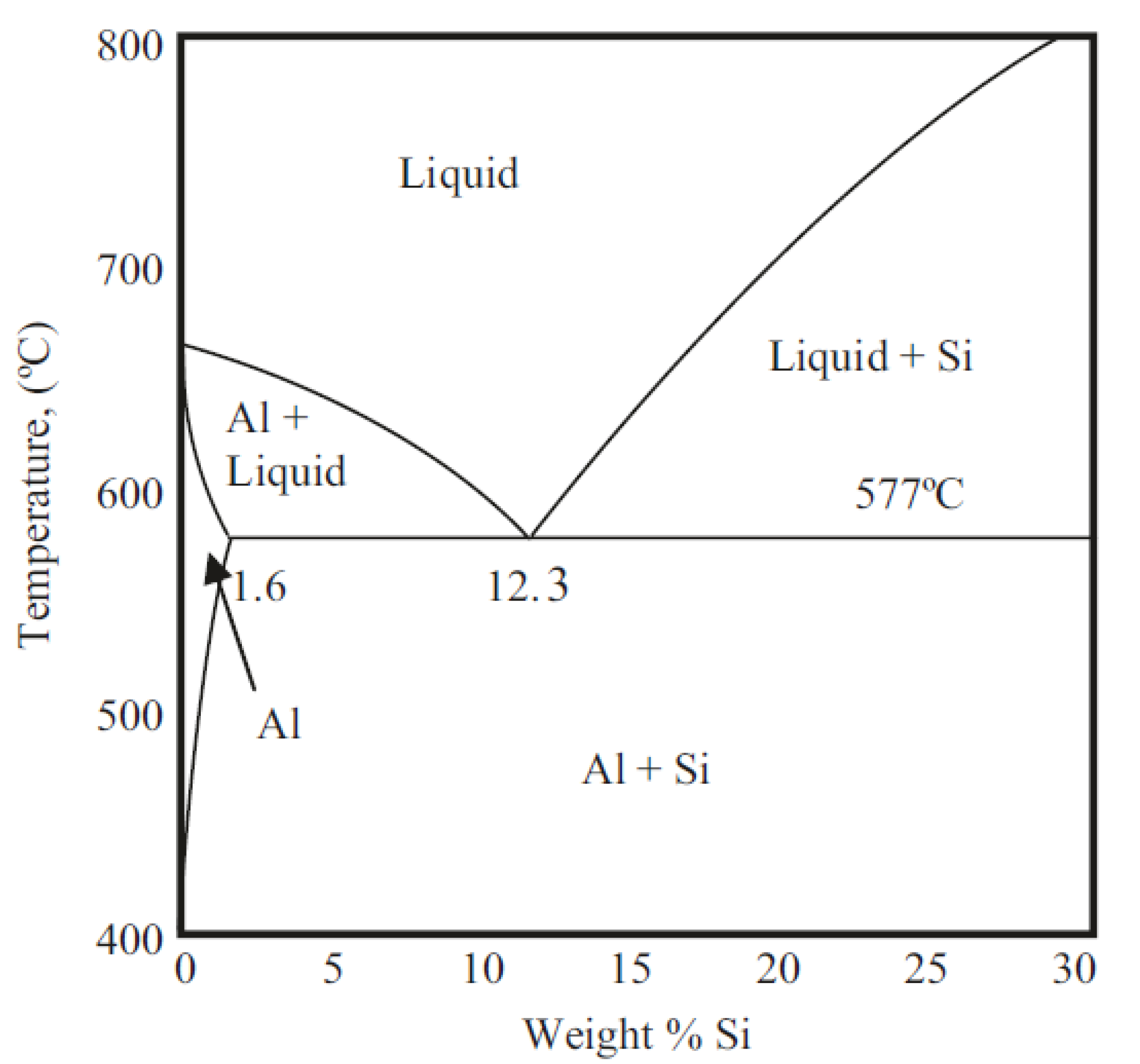
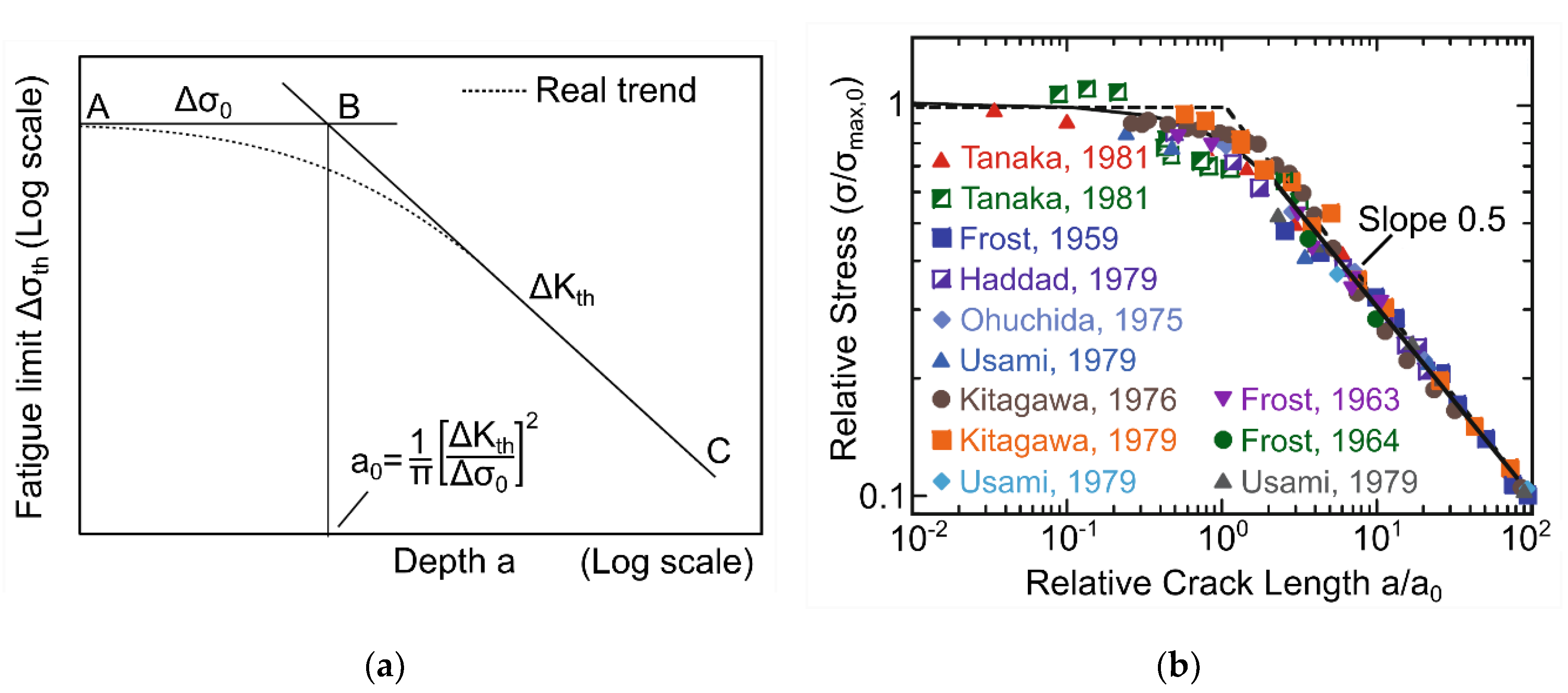
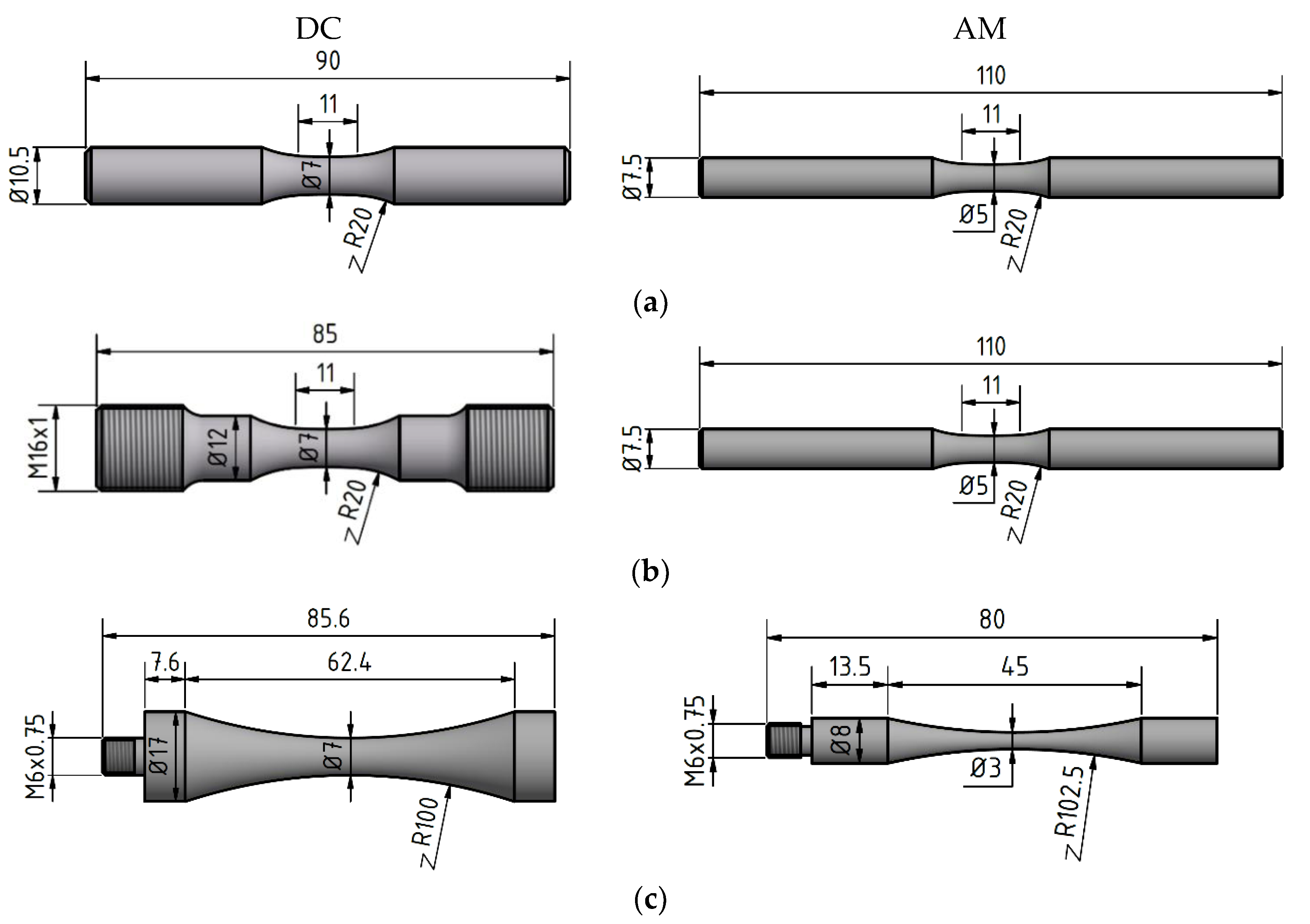
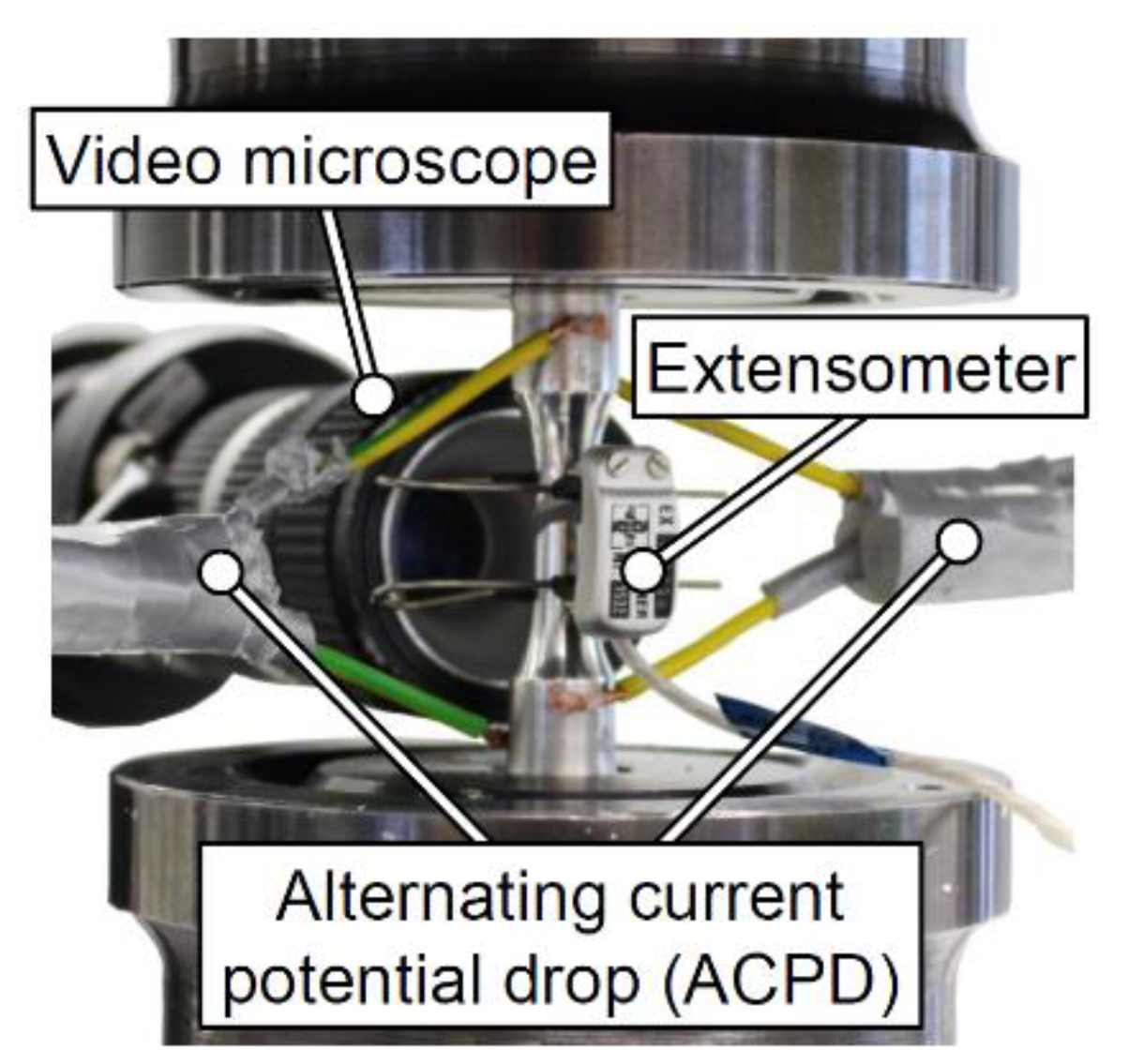
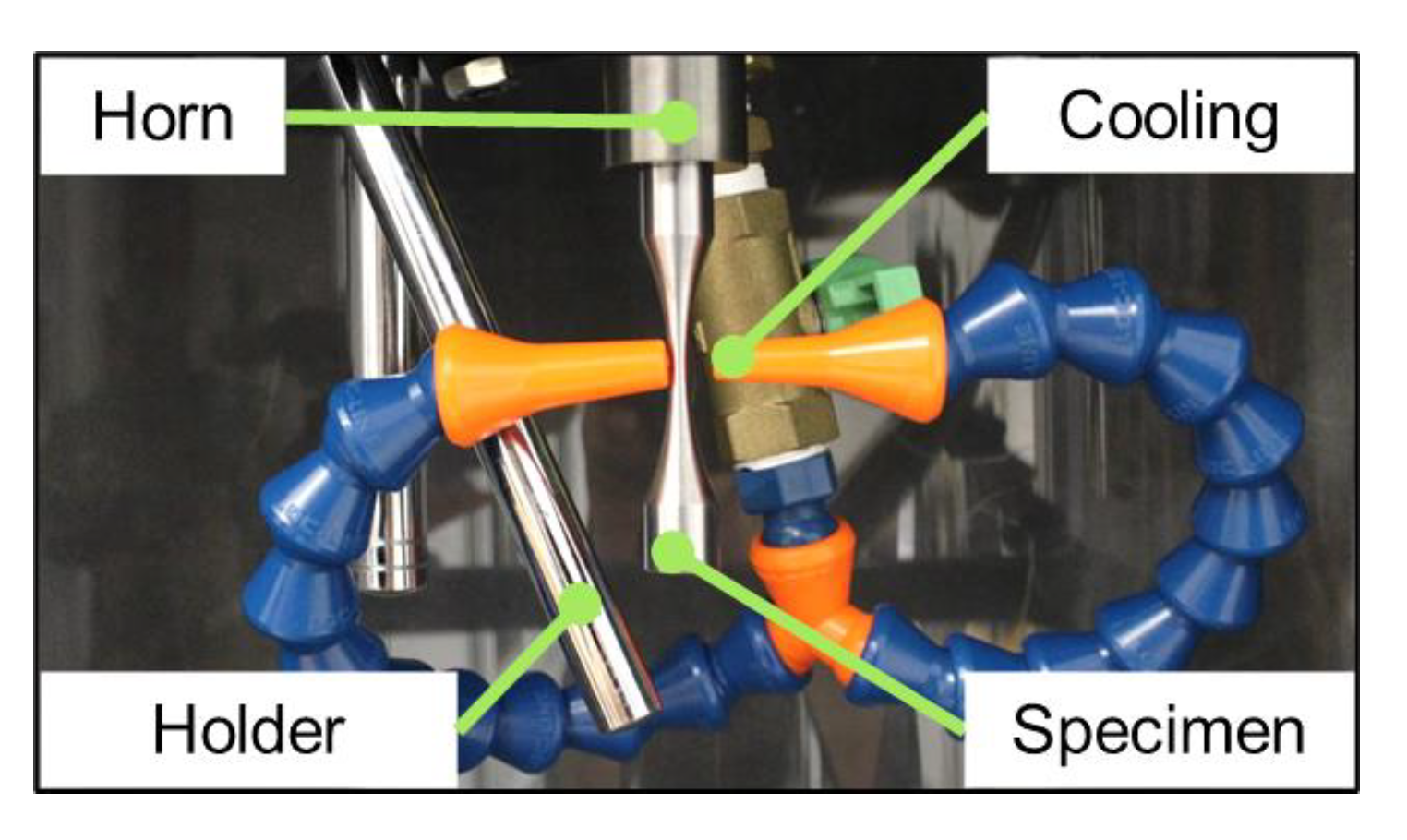

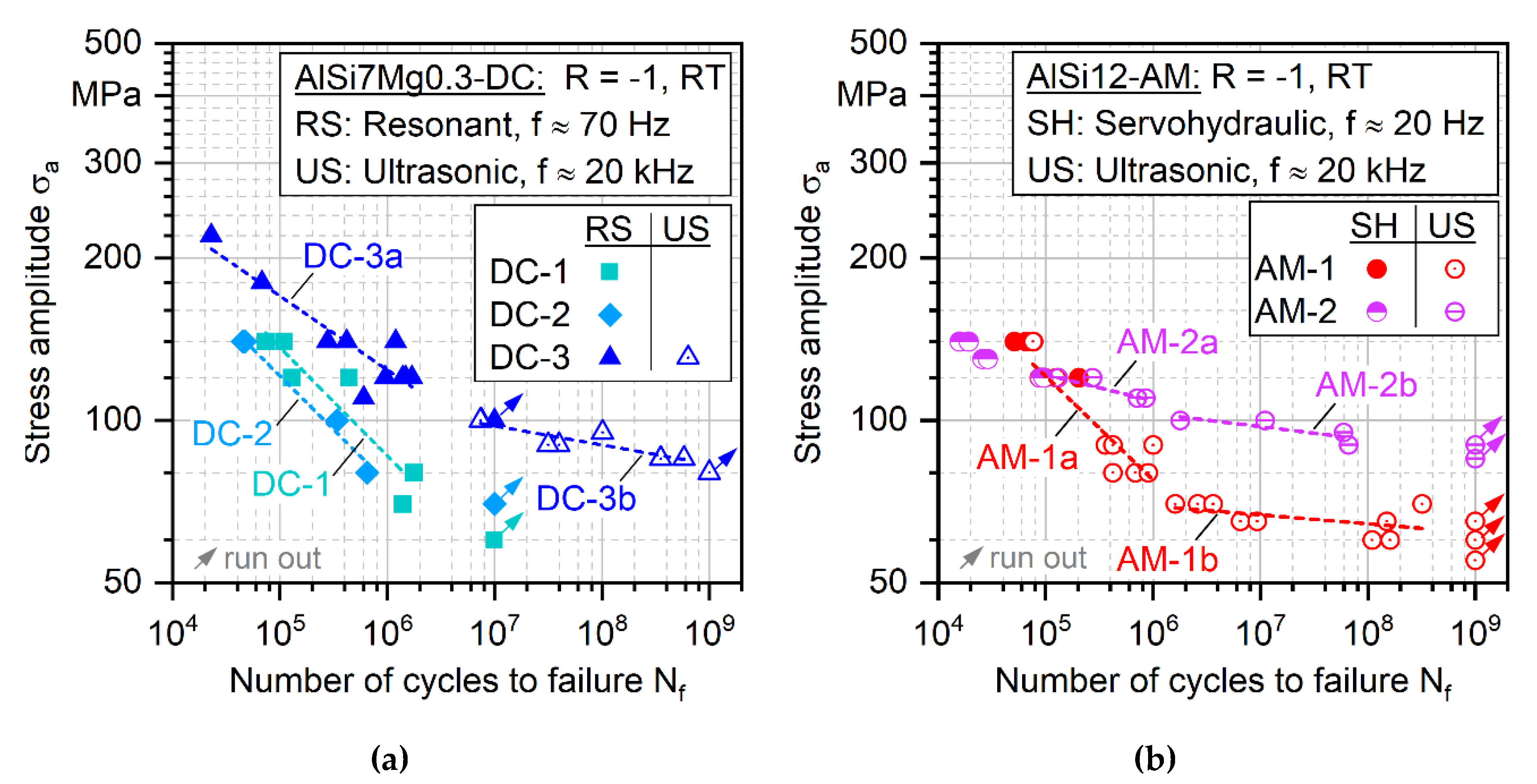
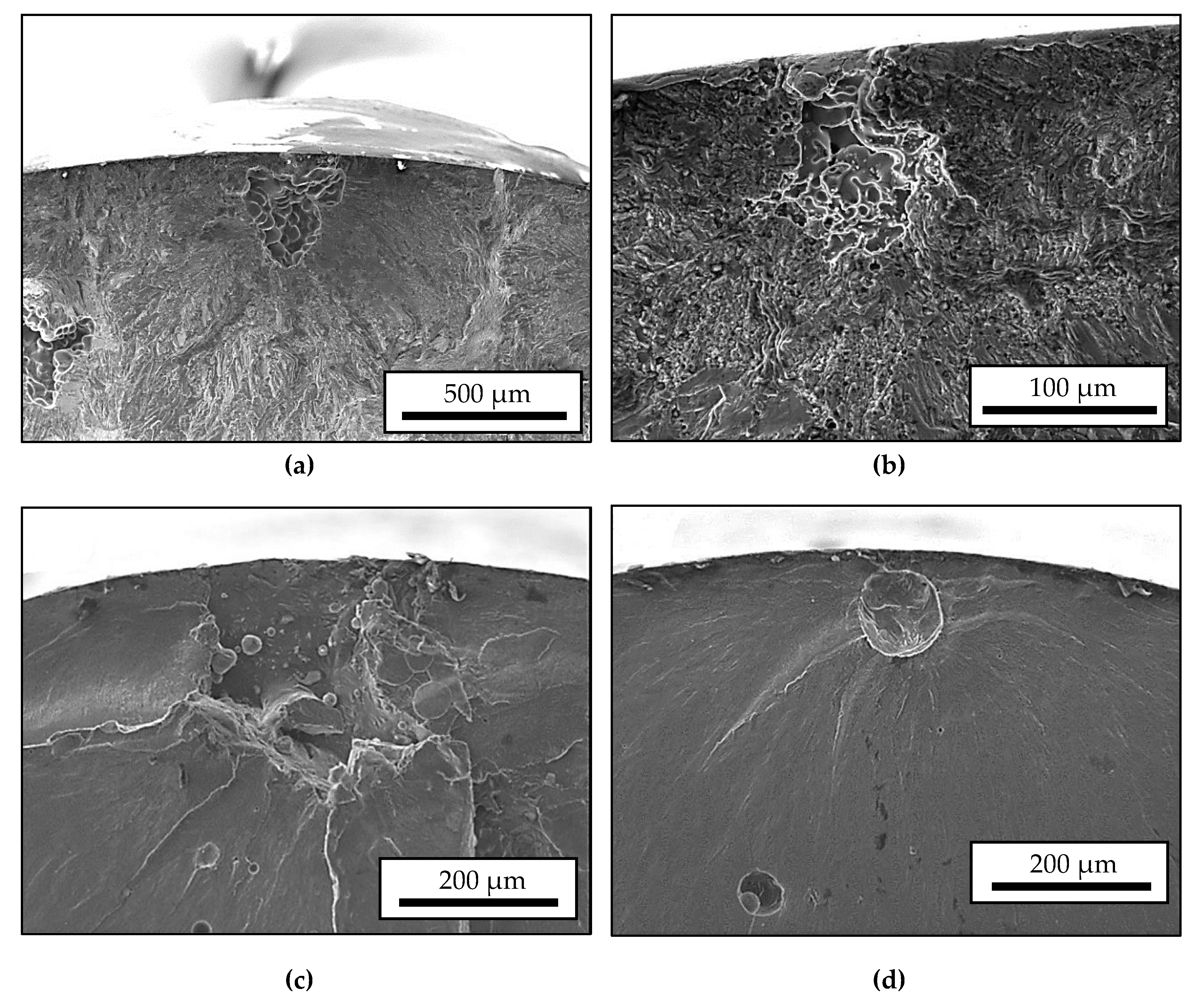
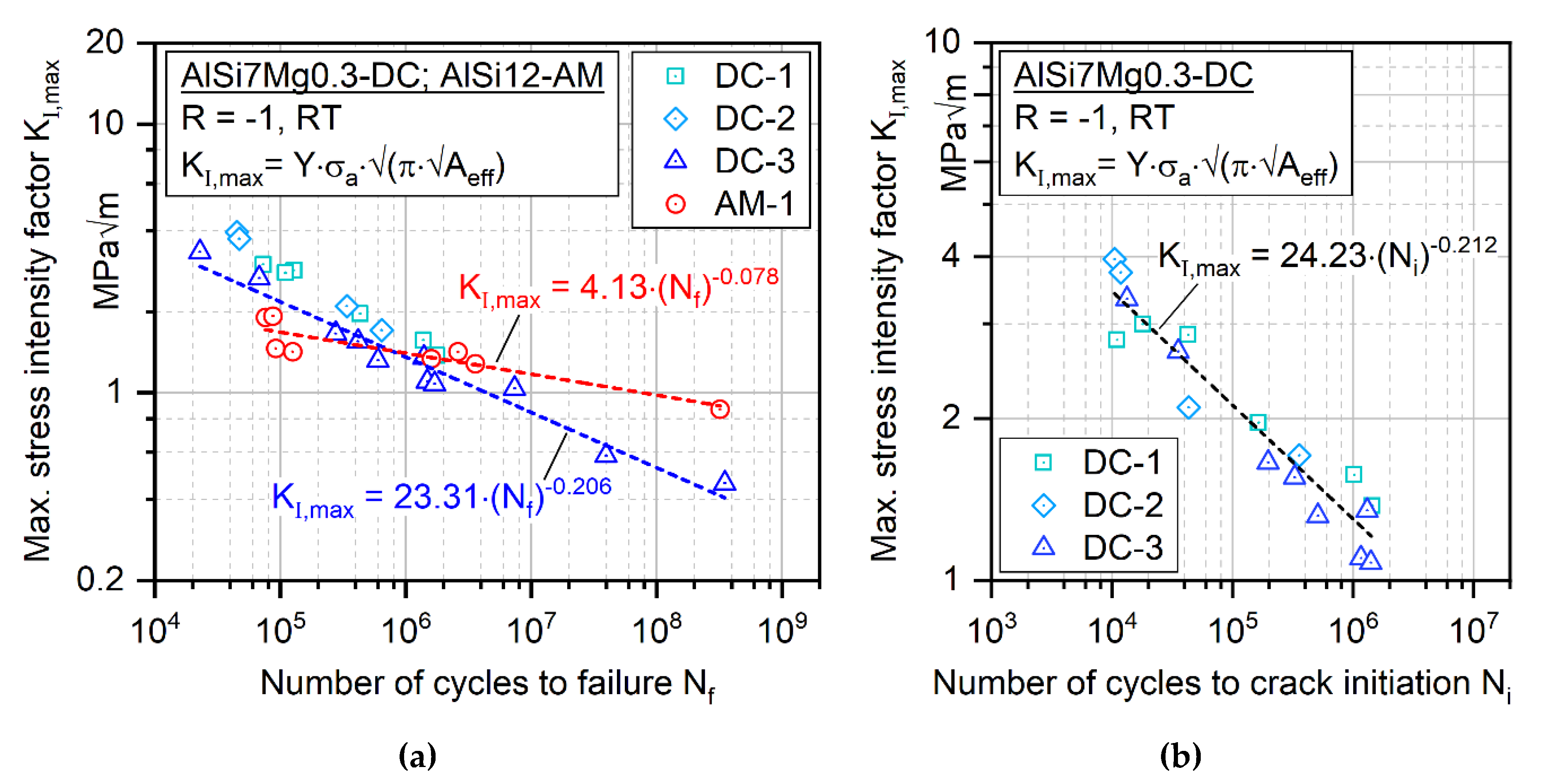
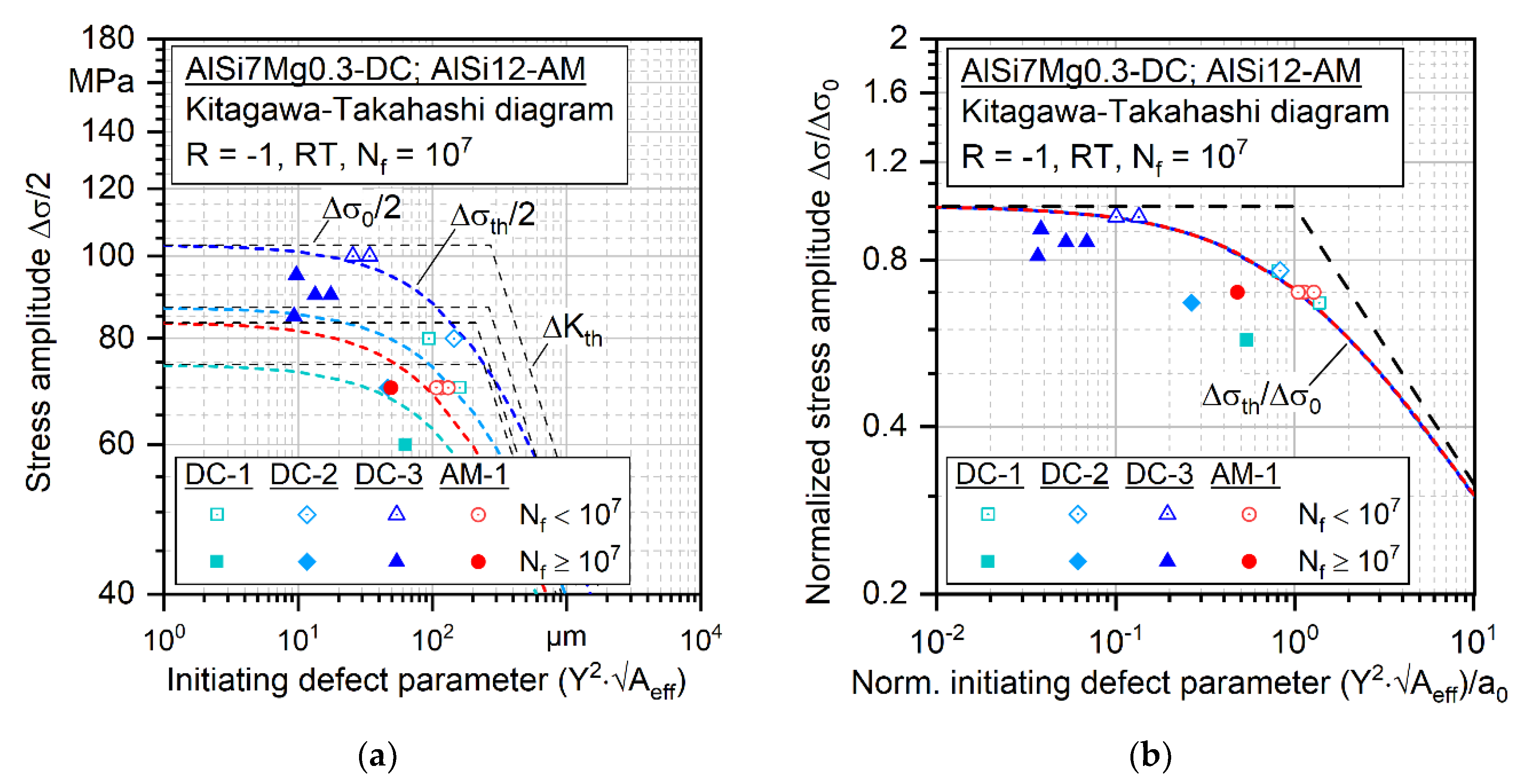
| Process | Alloy | Si | Mg | Fe | Mn | Ti | Al |
|---|---|---|---|---|---|---|---|
| DC | AlSi7Mg0.3 | 7.5 | 0.288 | 0.094 | 0.0018 | 0.146 | Bal. |
| AM | AlSi12 | 11.0–13.0 | 0.10 | 0.6 | 0.15 | n.a. | Bal. |
| Batch | Grain Size [µm] | Dendrite Size [µm] | Area [µm2] | Major Axis [µm] | Minor Axis [µm] | [–] |
|---|---|---|---|---|---|---|
| DC-1 | 628 ± 312 | 34.1 ± 3.0 | 5.11 | 3.06 | 1.71 | 0.91 |
| DC-2 | 660 ± 266 | 35.1 ± 5.0 | 4.10 | 2.75 | 1.61 | 0.85 |
| DC-3 | 562 ± 300 | 35.3 ± 5.1 | 5.69 | 3.25 | 1.79 | 0.84 |
| AM-1 | - | 0.31 ± 0.17 * | - | - | - | - |
| AM-2 | - | 0.46 ± 0.23 * | - | - | - | - |
| Batch | HV10 | E [GPa] | [MPa] | [MPa] | [MPa] | |
|---|---|---|---|---|---|---|
| DC-1 | 96 ± 6 | 71.5 ± 3.2 | 153 ± 16 | 196 ± 18 | 253 ± 1 | 5.6 ± 2.2 |
| DC-2 | 92 ± 3 | 73.0 ± 2.0 | 149 ± 22 | 192 ± 14 | 257 ± 20 | 5.6 ± 1.0 |
| DC-3 | 108 ± 1 | 74.6 ± 2.5 | 185 ± 4 | 237 ± 3 | 308 ± 5 | 9.4 ± 1.5 |
| AM-1 | 107 ± 3 | 76.7 ± 4.2 | 145 ± 4 | 218 ± 7 | 372 ± 7 | 3.4 ± 0.29 |
| AM-2 | 100 ± 4 | 72.5 ± 4.3 | 126 ± 4 | 201 ± 4 | 361 ± 5 | 4.1 ± 0.15 |
| Basquin | DC-1 | DC-2 | DC-3a | DC-3b | AM-1a | AM-1b | AM-2a | AM-2b |
| [MPa] | 1382 | 1193 | 821 | 172 | 1107 | 87 | 212 | 144 |
| b | −0.201 | −0.199 | −0.137 | −0.035 | −0.193 | −0.017 | −0.048 | −0.024 |
| Batch | m [–] | [MPa] | [µm] | [µm] | [µm] | [MPa] | ||
|---|---|---|---|---|---|---|---|---|
| DC-1 | 4.9 | 3.5 | 4.1 | 120 * | 372 | 313 | 240 | 149 |
| DC-2 | 5.2 | 4.3 | 5.0 | 140 * | 406 | 338 | 263 | 174 |
| DC-3 | 5.4 | 5.2 | 6.0 | 196 | 298 | 65 | 271 | 206 |
| AM-1 | 2.7 | 3.2 | 4.3 | 134 | 328 | 279 | 210 | 167 |
| AM-2 | 2.8 | 3.5 | 4.7 | - | - | - | 185 | 195 |
© 2020 by the authors. Licensee MDPI, Basel, Switzerland. This article is an open access article distributed under the terms and conditions of the Creative Commons Attribution (CC BY) license (http://creativecommons.org/licenses/by/4.0/).
Share and Cite
Tenkamp, J.; Awd, M.; Siddique, S.; Starke, P.; Walther, F. Fracture–Mechanical Assessment of the Effect of Defects on the Fatigue Lifetime and Limit in Cast and Additively Manufactured Aluminum–Silicon Alloys from HCF to VHCF Regime. Metals 2020, 10, 943. https://doi.org/10.3390/met10070943
Tenkamp J, Awd M, Siddique S, Starke P, Walther F. Fracture–Mechanical Assessment of the Effect of Defects on the Fatigue Lifetime and Limit in Cast and Additively Manufactured Aluminum–Silicon Alloys from HCF to VHCF Regime. Metals. 2020; 10(7):943. https://doi.org/10.3390/met10070943
Chicago/Turabian StyleTenkamp, Jochen, Mustafa Awd, Shafaqat Siddique, Peter Starke, and Frank Walther. 2020. "Fracture–Mechanical Assessment of the Effect of Defects on the Fatigue Lifetime and Limit in Cast and Additively Manufactured Aluminum–Silicon Alloys from HCF to VHCF Regime" Metals 10, no. 7: 943. https://doi.org/10.3390/met10070943
APA StyleTenkamp, J., Awd, M., Siddique, S., Starke, P., & Walther, F. (2020). Fracture–Mechanical Assessment of the Effect of Defects on the Fatigue Lifetime and Limit in Cast and Additively Manufactured Aluminum–Silicon Alloys from HCF to VHCF Regime. Metals, 10(7), 943. https://doi.org/10.3390/met10070943









